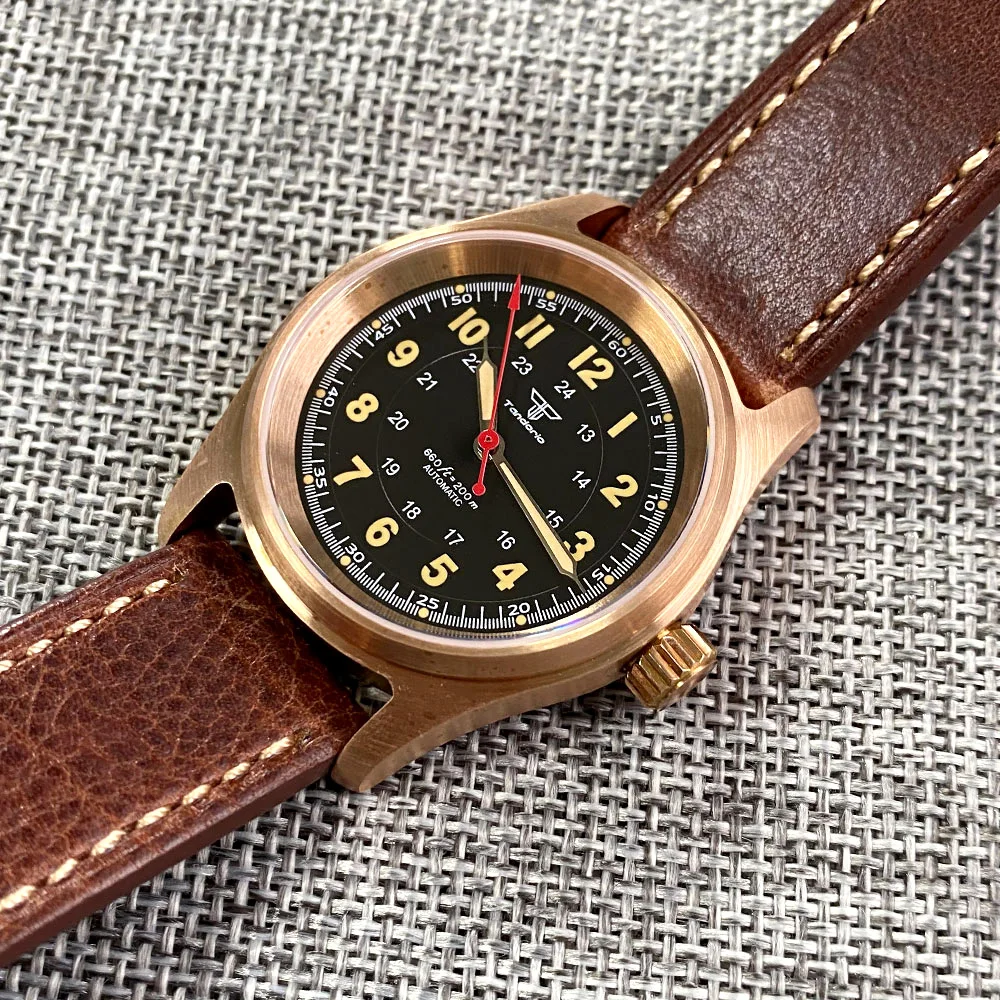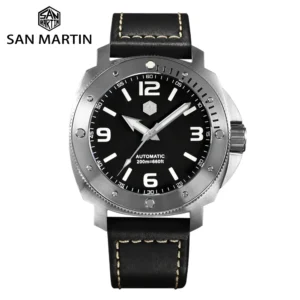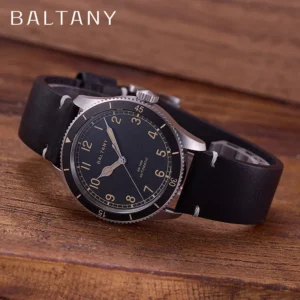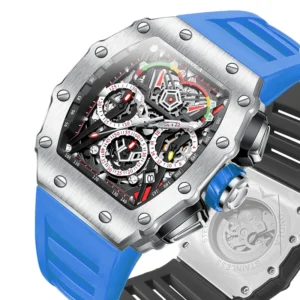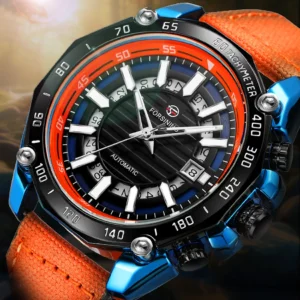Introduction: The Unique Appeal of Bronze Watches and Their Patina
Bronze watches have carved out a special place in the luxury timepiece market, offering wearers something truly extraordinary – a living, evolving accessory that changes over time. But what exactly is bronze? At its core, bronze is an alloy primarily composed of copper and tin, sometimes with small amounts of other metals like aluminum or nickel. This composition gives bronze remarkable durability, corrosion resistance (particularly in saltwater), and a distinctive warm, golden-reddish hue when new.
What truly sets bronze watches apart is their ability to develop patina – a natural oxidation layer that forms on the surface as the metal reacts with its environment. Unlike tarnish or rust, patina is actually a desirable characteristic that transforms each bronze timepiece into a unique reflection of its owner’s journey. The watch you wear while hiking mountain trails will develop differently from one worn primarily in an office setting or at the beach.
This natural aging process connects modern bronze watches to their rich maritime heritage, where bronze was prized for navigational instruments and ship fittings due to its resistance to saltwater corrosion. The history of dive watch engineering shows how bronze has been valued for its practical benefits long before becoming fashionable in luxury timepieces.
In this comprehensive guide, we’ll explore how patina forms on bronze automatic watches, what influences its development, and how you can either embrace or control this fascinating process that makes your timepiece uniquely yours.
The Science Behind Bronze Patina Formation
Understanding how patina forms on your bronze watch begins with basic chemistry. The process that creates this distinctive surface layer is fundamentally different from rusting, which affects iron-based metals through destructive oxidation.
The Oxidation Process
At its core, patina formation is an oxidation process – the chemical reaction that occurs when the copper in bronze interacts with oxygen in the air. This creates copper oxide (CuO), the foundation of patina. The basic reaction looks like this:
2Cu + O₂ → 2CuO
While this simple reaction forms the dark brown or black base layer of patina, the beautiful complexity of colors comes from additional reactions.
Beyond Simple Oxidation
Bronze patina gets its rich character when copper reacts with other environmental elements beyond just oxygen:
- Copper carbonates: Form when copper reacts with carbon dioxide and moisture, creating green-blue compounds
- Copper sulfides: Develop through reactions with sulfur compounds in the air, producing darker tones
- Copper chlorides: Result from exposure to chlorides (like salt), creating unique greenish patinas
Alloy Composition Differences
The specific bronze alloy in your watch significantly impacts how patina develops. Traditional bronze contains about 88% copper and 12% tin, while modern watchmakers often use aluminum bronze (with aluminum replacing some tin) or other variations:
- Aluminum bronze: Generally develops patina more slowly and evenly
- Traditional tin bronze: Often creates more dramatic, varied patination
- Silicon bronze: Tends to develop more subtle, uniform patinas
The chemical processes involved in patina formation vary slightly between these different alloys, but all share the fundamental oxidation principle that transforms the fresh, golden surface into something with depth and character.
Environmental Factors Accelerating Patina Development
The environment where you wear or store your bronze watch plays a crucial role in how quickly and in what pattern patina develops. Understanding these factors helps explain why two identical watches can look completely different after months of wear.
Humidity and Moisture
Water molecules are catalysts for the oxidation reactions that create patina:
- High humidity environments accelerate patina formation dramatically
- Tropical climates often produce quicker, more pronounced patination
- Desert or dry climate wearers might notice much slower development
- Direct water exposure (swimming, washing hands) creates localized reaction spots
Air Quality and Pollutants
The chemical composition of the air around your watch affects patina development:
- Urban environments with higher sulfur dioxide levels create darker patinas
- Industrial areas may produce more varied color development
- Clean mountain air typically results in slower, more even patination
- Indoor environments with cooking fumes can create unique patterns
Salt Exposure
Salt (sodium chloride) is particularly influential in patina formation:
- Coastal environments accelerate the process through airborne salt
- Sweat contains salt that creates distinctive patterns where the watch contacts skin
- Saltwater swimming creates dramatic, often uneven patination
- Salt spray exposure creates distinctive blue-green verdigris patterns
Temperature Effects
Heat is a catalyst for chemical reactions, including those forming patina:
- Warm climates speed up the oxidation process
- Cold environments slow patina development considerably
- Temperature fluctuations can create interesting layered effects
- Skin temperature affects patina formation on the caseback more than the front
Various factors affecting bronze watch patina development work in combination, creating an endless variety of possible outcomes that make each timepiece uniquely personal.

Personal Factors Influencing Your Watch’s Patina
Beyond environmental conditions, your own body chemistry and habits play a significant role in how your bronze watch develops its unique character. These personal factors create the intimate connection between wearer and timepiece that makes bronze watches so special.
Skin Chemistry
Everyone’s skin has a slightly different chemical composition:
- Higher skin pH (more alkaline) typically accelerates patina formation
- Acidic skin chemistry can create distinctive patination patterns
- Skin oils create a natural barrier affecting oxidation rates
- Some people’s sweat contains higher mineral content, creating more varied patinas
Wearing Patterns
How often and how you wear your watch dramatically impacts patina development:
- Daily wear creates more even patination through consistent exposure
- Occasional wear often results in spotty or uneven development
- Wearing the watch tight against the skin versus loosely affects moisture contact
- Left versus right wrist placement exposes the watch to different activities
Activity Levels
Your lifestyle directly affects how your watch ages:
- Active sports create friction that can polish high points while deepening patina in recessed areas
- Swimming (especially in salt water) dramatically accelerates and alters patination
- Outdoor activities expose the watch to diverse environmental elements
- Desk jobs may create distinctive wear patterns where the watch contacts work surfaces
The natural aging process of bronze watches is truly a reflection of your personal lifestyle, making each timepiece a visual diary of your experiences.
Visual Characteristics: The Rainbow of Bronze Patina Colors
One of the most fascinating aspects of bronze watches is the incredible range of colors that develop during patination. Understanding what causes these variations helps you appreciate the unique artwork developing on your wrist.
Brown and Chocolate Tones
The early stages of patina usually manifest as warm brown tones:
- Light tan coloration appears first, often within days of wear
- Medium brown tones develop as the oxidation layer thickens
- Rich chocolate colors emerge as the patina matures
- Reddish-brown areas often indicate areas of frequent skin contact
These warm tones result primarily from copper oxide formation and represent the foundation of most patina development.
Green Verdigris
Perhaps the most iconic patina color, green appears as:
- Subtle mint green flecks in early stages
- Brighter green areas near points of moisture or salt exposure
- Deep forest green in mature patinas, especially in humid environments
- Bluish-green tones in areas with high chloride exposure
These green colors come from copper carbonates and copper chlorides forming on the surface.
Blue and Turquoise Hues
Less common but highly prized are the blue tones that can develop:
- Turquoise patches typically require specific environmental conditions
- Azure blue highlights sometimes appear in recessed areas
- Navy blue tones can develop with certain alloy compositions
- Teal transitions where blue and green patinas meet
Blue patina usually indicates the presence of azurite (a copper carbonate mineral) forming on the surface.
Red, Purple, and Black Variations
The most complex patinas may include:
- Reddish highlights from cuprite formation
- Purple-black areas indicating copper sulfide compounds
- Deep black regions where oxidation is particularly heavy
- Iridescent purple flashes that appear in certain lighting conditions
Many field watches where patina development is often embraced showcase these rich, varied color developments that tell the story of where the watch has been and what it has experienced.
Timeline: How Long Does Patina Development Take?
One of the most common questions about bronze watches concerns timing – how quickly will that beautiful patina develop? While every watch follows its own journey, there are general timelines that can help set expectations.
Initial Changes (Days to Weeks)
The first signs of patina appear surprisingly quickly:
- Dulling of the bright polish within hours of first exposure
- Subtle darkening around edges and details within 1-3 days
- First hints of color variation appearing within the first week
- Loss of the “new penny” brightness within 2-3 weeks
Early Development (1-3 Months)
The formative period shows significant changes:
- Distinct darkening of recessed areas by one month
- First substantial color variations emerging
- Uneven character developing based on wear patterns
- Foundation of the watch’s long-term patina establishing itself
Maturation Period (6-12 Months)
The character-building phase brings:
- Deep, rich colors fully establishing
- More uniform coverage across the watch case
- Stabilization of the patina’s base character
- Distinct personality emerging based on the wearer’s lifestyle
Long-Term Evolution (Years)
The ongoing relationship continues with:
- Subtle deepening of established colors
- Greater contrast between worn and protected areas
- Increasingly stable surface requiring less frequent cleaning
- Development of what collectors call “soul” or “wabi-sabi”
The evolution of dive watch technology shows how bronze models continue to change over years of use, creating timepieces that truly tell a story.
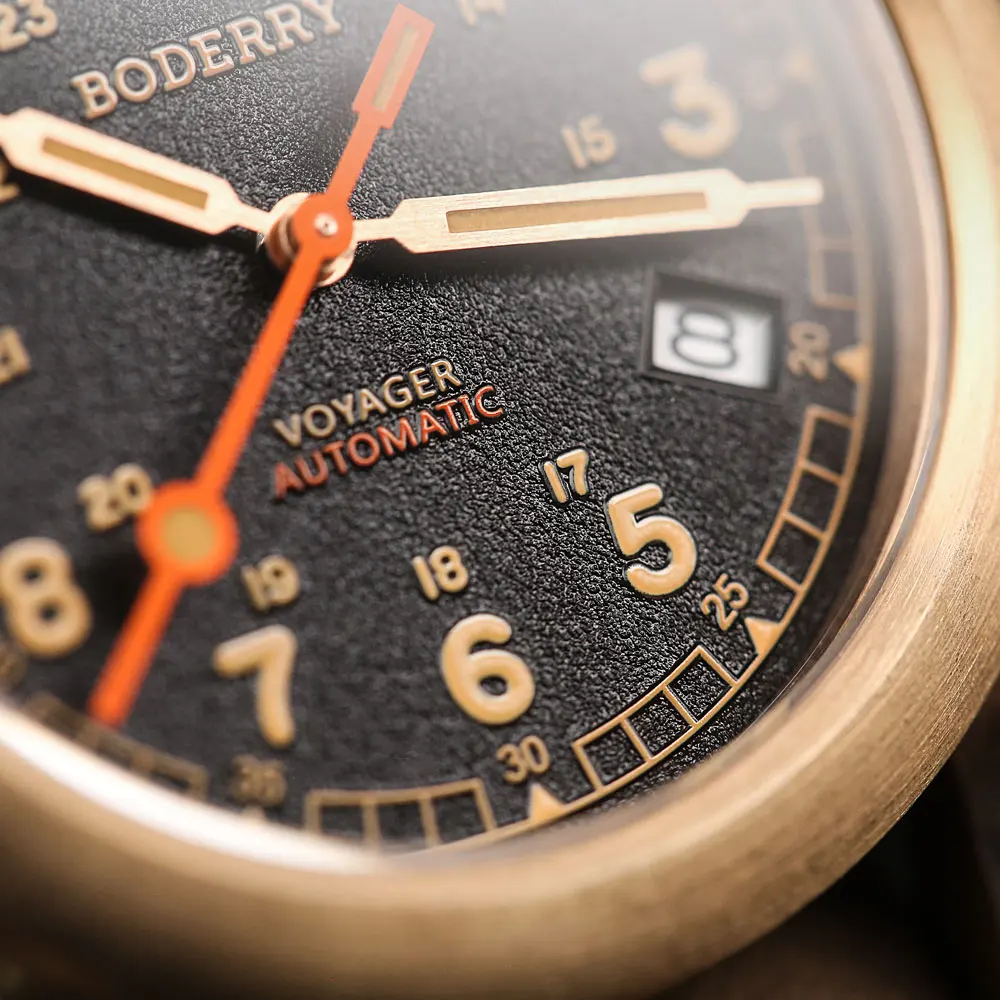
Protection vs. Corrosion: Understanding Patina’s Role
A common misconception about patina is that it damages bronze watches. In reality, patina actually serves a protective function – but there’s an important distinction between beneficial patina and problematic corrosion.
The Protective Shield
Stable patina forms a natural barrier that prevents further corrosion:
- The oxidation layer seals the underlying metal from direct exposure
- Once established, patina slows down further chemical reactions
- The surface compounds are more stable than raw bronze
- Properly formed patina actually preserves the structural integrity of the watch
Bronze Disease vs. Healthy Patina
While normal patina is beneficial, “bronze disease” is a destructive condition:
- Healthy patina: Even coloration, stable surface, no powdering or flaking
- Bronze disease: Powdery light green spots, progressive damage, unstable surface
This harmful corrosion typically occurs when chlorides penetrate the patina layer and continue reacting with the bronze underneath, creating copper chloride that continues converting metal to corrosion products.
Warning Signs to Watch For
How to distinguish between normal patination and problematic corrosion:
- Powdery residue that easily wipes off suggests potential problems
- Pitting or visible metal loss indicates destructive processes
- Patina that continues to change rapidly even in stable conditions
- Flaking or scaling of the surface beyond normal texture development
The “Bronze Sickness” Phenomenon
Many new bronze watch owners notice green discoloration on their skin – this is normal and harmless:
- Copper compounds from the watch transfer to skin through sweat
- This “verdigris transfer” washes off easily with soap and water
- The effect typically diminishes as the watch develops stable patina
- This is not an allergic reaction but simple pigment transfer
For comprehensive information on maintaining your timepiece, the bronze watch care guide offers detailed advice for preserving its beauty while allowing character development.
Maintenance: Caring for Your Bronze Watch’s Patina
Whether you cherish your watch’s developing patina or prefer to maintain a certain look, proper maintenance ensures your timepiece remains beautiful for generations.
Embracing Natural Development
Many collectors prefer the hands-off approach:
- Allow natural oils from handling to create an even, protective layer
- Avoid harsh chemicals or cleaners that disrupt the natural process
- Understand that temporary unevenness often resolves into character
- Appreciate the unique story each mark and color variation represents
Gentle Cleaning Techniques
For basic maintenance without removing patina:
- Use a soft, slightly damp microfiber cloth to remove dust and oils
- Avoid commercial metal polishes which can strip patina
- Clean areas that contact skin more frequently to prevent irritation
- Pay special attention to areas between lugs and under straps where moisture collects
Protective Measures
To stabilize a patina you particularly enjoy:
- Apply a thin layer of microcrystalline wax with a soft cloth
- Consider Renaissance Wax, a museum-quality protectant
- Use watch-specific oils that create a protective barrier
- Reapply protection after swimming or heavy sweating
Storage Recommendations
When not wearing your bronze timepiece:
- Store in a low-humidity environment
- Consider silica gel packets in your watch box to control moisture
- Avoid airtight containers which can trap humidity
- Keep away from chemical fumes or cleaning products
Rugged automatic watches with bronze cases benefit particularly from proper storage practices to develop the rich, even patina many collectors prize.
Military Inspired Automatic Watches, Rugged Automatic Watches, Tactical Automatic Watches
Price range: $852.14 through $994.60 Select options This product has multiple variants. The options may be chosen on the product pageBronze Automatic Watches, Military Inspired Automatic Watches, Professional Spec Dive Watches
Price range: $1,442.21 through $1,442.82 Select options This product has multiple variants. The options may be chosen on the product pageClassic Pilot Watches, Military Inspired Automatic Watches
$561.00 Select options This product has multiple variants. The options may be chosen on the product pageRugged Automatic Watches, Unique Automatic Watches
Price range: $228.96 through $231.10 Select options This product has multiple variants. The options may be chosen on the product pageClassic Field Watches, Military Inspired Automatic Watches
Price range: $280.87 through $338.51 Select options This product has multiple variants. The options may be chosen on the product pageAutomatic Skeleton Watches, Military Inspired Automatic Watches, Unique Automatic Watches
$191.88 Select options This product has multiple variants. The options may be chosen on the product page
Resetting the Canvas: Methods to Remove Patina
While many collectors cherish patina development, there are valid reasons to occasionally reset your bronze watch to its original appearance – whether to start the aging process anew or to address problematic patination.
When to Consider Removal
Common reasons to remove patina include:
- Uneven or blotchy development you find unappealing
- Preparing to sell or gift the watch
- Starting fresh after environmental damage
- Creating a baseline for controlled patination experiments
Natural Cleaning Solutions
Gentle home methods to restore bronze:
- Lemon juice method: Apply fresh lemon juice with a soft cloth, let sit briefly, then rinse thoroughly
- Vinegar solution: Create a paste with equal parts white vinegar and flour, apply gently, then rinse
- Baking soda paste: Mix baking soda with water for a mild abrasive cleaning paste
- Tomato ketchup: The acidity works well for light cleaning (apply, wait 15 minutes, rinse)
Commercial Products
Specialized products designed for safe bronze cleaning:
- Dedicated bronze cleaners formulated for watches
- Copper-specific polishes (test in an inconspicuous area first)
- Non-abrasive metal polish cloths
- Watch-safe jewelry cleaning solutions
Protection During Cleaning
Critical areas to protect when cleaning:
- Apply petroleum jelly to gaskets and seals before cleaning
- Avoid getting cleaning solutions near the crown or pushers
- Protect the crystal with tape if using pastes or abrasives
- Keep solutions away from the movement and caseback gaskets
The historical perspective on bronze in professional diving watches shows how these timepieces have traditionally been maintained while preserving their functionality.
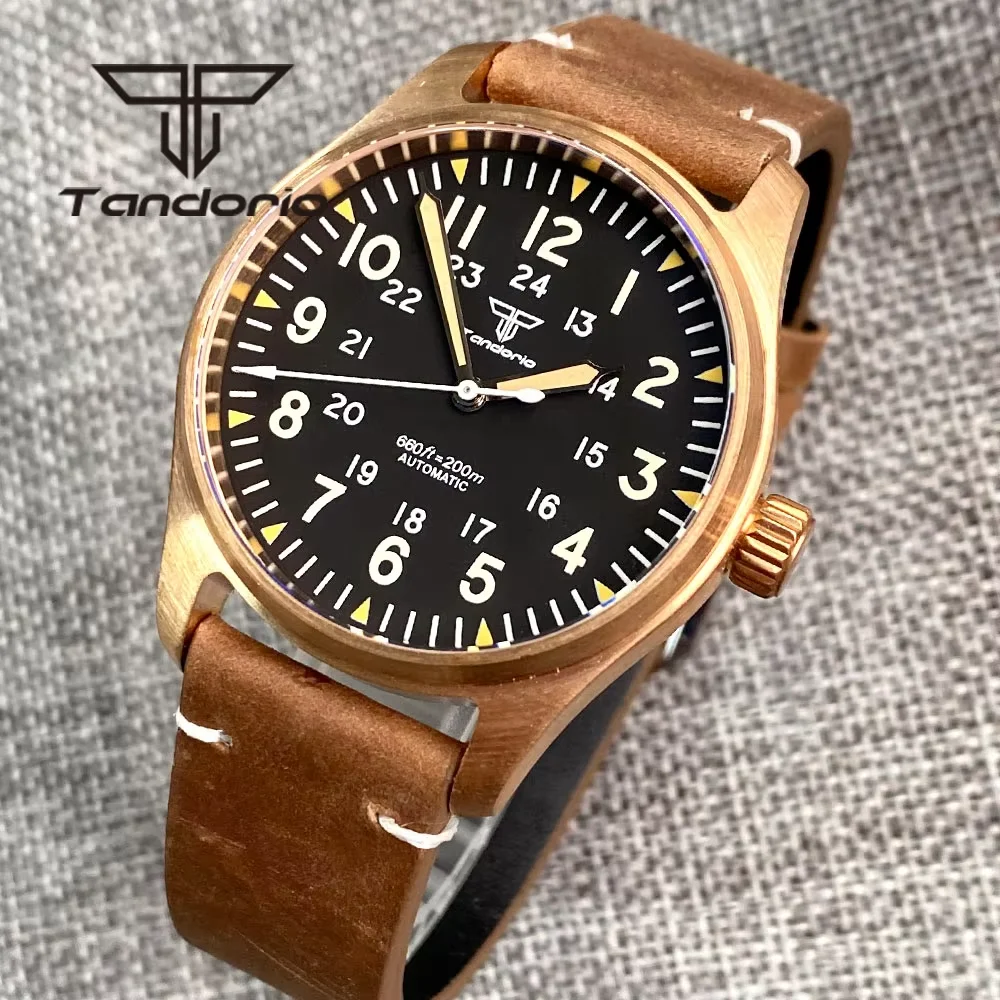
Forced Patination: Creating Artificial Patina Effects
For those who don’t want to wait for natural processes, forced patination offers a way to create distinctive patina effects quickly and deliberately. This approach lets you control the outcome rather than leaving it to chance.
Why Consider Artificial Patination
Reasons collectors might choose forced methods:
- Desire for immediate character rather than waiting months
- Seeking specific aesthetic effects not easily achieved naturally
- Creating an even base patina before allowing natural wear to add character
- Experimenting with unique looks not possible through natural means
Saltwater Method (Basic Technique)
A gentle introduction to forced patination:
- Prepare a solution of warm water and sea salt (1-2 tablespoons per cup)
- Dip the watch case briefly or apply with a soft brush
- Allow to air dry without rinsing
- Repeat for deeper effects, monitoring closely between applications
Liver of Sulfur Technique
For more dramatic results (requires proper ventilation):
- Mix liver of sulfur gel with warm water following product instructions
- Dip the watch briefly (seconds, not minutes)
- Rinse immediately with clean water to stop the reaction
- Dry thoroughly and evaluate before additional applications
Ammonia Vapor Method
For creating blue-green patinas (use extreme caution and proper ventilation):
- Place the watch on a stand above a small container of household ammonia
- Cover both with a larger container creating a sealed environment
- Allow vapor to react with the bronze (checking frequently)
- Remove and rinse thoroughly once desired effect is achieved
Safety First
Critical precautions for any chemical patination:
- Work in well-ventilated areas or outdoors
- Wear protective gloves to prevent skin contact
- Use eye protection when working with chemicals
- Follow all product safety guidelines precisely
- Never mix chemicals unless specifically directed
For those interested in more controlled approaches, detailed guides on artificial patination techniques can help you achieve specific effects safely.
Frequently Asked Questions About Bronze Watch Patina
Is bronze watch patina harmful to the watch?
No, stable patina actually protects bronze by forming a barrier against deeper corrosion. Unlike rust on steel, patina doesn’t compromise the structural integrity of the watch case. In fact, many manufacturers intentionally choose bronze precisely because of how it develops this protective character over time.
Can patina affect the water resistance of my watch?
Patina itself doesn’t reduce water resistance. However, the crown, caseback seal, and gaskets should be regularly inspected and maintained regardless of case material. Bronze watches require the same water resistance maintenance as any other timepiece – regular testing and gasket replacement as recommended by the manufacturer.
Does patina affect the value of bronze watches?
Generally, an evenly developed, attractive patina enhances rather than diminishes the value of bronze watches among collectors. Many enthusiasts specifically seek out well-patinated examples with character. That said, some buyers prefer the option to develop their own patina, so including before and after cleaning photos when selling can be helpful.
Is the green discoloration on my skin from wearing a bronze watch harmful?
The green marks sometimes left on skin are harmless copper compounds transferring through sweat. This “verdigris transfer” washes off easily with soap and water and becomes less common as the watch develops stable patina. It’s simply a cosmetic issue, not a health concern.
How does bronze patina differ from brass or copper patina?
While all three materials develop patina through copper oxidation, the results differ subtly:
– Bronze patina (copper-tin alloy): Usually more even, tends toward browns and warm tones
– Brass patina (copper-zinc alloy): Often yellower, develops green patina more readily
– Pure copper patina: Typically develops the most vivid greens and blues
Can I prevent patina entirely?
While difficult to prevent completely, you can significantly slow patina development by:
1. Applying watch-specific protective coatings
2. Regular gentle cleaning with a soft cloth
3. Storing the watch in low-humidity environments
4. Promptly drying after exposure to moisture or sweat
However, many would argue that preventing patina defeats the purpose of choosing a bronze watch in the first place.
Will scratches in the patina “heal” over time?
Yes! One of the remarkable qualities of bronze watches is their ability to “self-heal” surface scratches. As patina continues to develop, it will eventually fill in and blend scratches, especially in recessed areas. This unique quality makes bronze watches increasingly attractive to those who appreciate wabi-sabi – the beauty of natural aging and imperfection.
For those seeking an even deeper understanding, the comprehensive resource on bronze as a watch case material explores these topics in greater detail.

